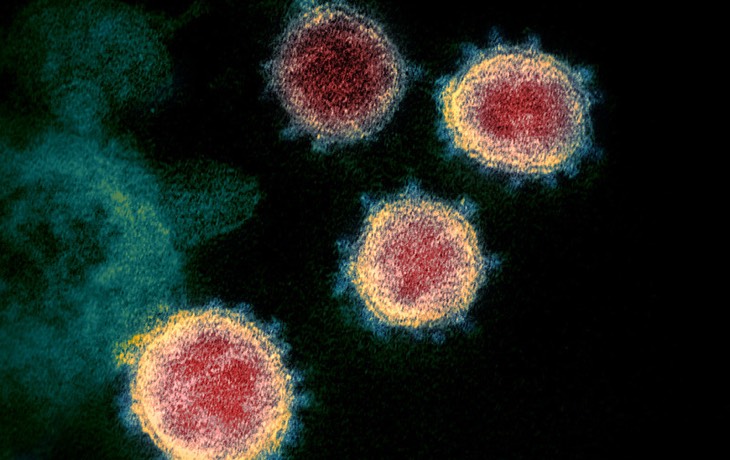Nothing in this article is a specific prediction. It’s a discussion of the range of things that could happen over the next few weeks with COVID and the factors that will determine which of these possibilities becomes actual.
To make things easier to talk about, here’s an internal framework we’ve been using internally at The Prepared when talking about the coronavirus:
The six levels of the COVID-19 pandemic
Regardless of the actual number of cases in any given location, the social and public health state of the epidemic in a particular place at a particular time can usefully be divided into a few discrete possibilities, or “levels” in our model. These levels describe the degree of SARS-CoV-2 transmission in an area, and any particular area may be at a higher level than is known at the time.
- Level 0: There are no active cases of COVID-19 in a given area. The default state of things.
- Level 1: There are some active cases of COVID-19, but they are all contained. Unless this containment is broken or more cases arrive, reversion to Level 0 will follow shortly.
- Level 2: There is local transmission of COVID-19, but it is small. If all the cases were known, they could e.g. be separated into clusters with some degree of accuracy.
- Level 3: There is widespread local transmission, e.g. enough to thwart cluster tracking even with good effort, but the disease burden is low enough that medical facilities are not overwhelmed.
- Level 4: The local disease burden is large enough to overwhelm medical facilities, but still small relative to the local population as a whole.
- Level 5: The local disease burden is large enough to make up a significant fraction of the local population.
The boundaries between these levels aren’t completely firm, but they’re still meaningful.
So far, the COVID-19 outbreak globally has pushed many areas of the world into Level 3, including most major Chinese cities and a number of European countries, plus US cities like Seattle and New York. However, only Hubei Province, China, the Lombardy region of Italy, Daegu, South Korea, and Qom, Iran, have reached Level 4.
Level 5 has not been seen yet outside of the Diamond Princess, which is an example of a severe coronavirus epidemic in an artificial, contained space.
Three ways of stopping the coronavirus: natural immunity, public health, and therapies
Given that the virus is largely the same everywhere it spreads (all speculation about different strains, aside), the difference between a region at level 2 and a region at level 3 is the local population’s response to the outbreak.
Keeping the virus contained and the medical system intact is all about controlling the virus’s spread — or, in epidemiological terms, getting the viral coefficient (usually denoted by the shorthand “R”) to drop. R is the number of people each infected person goes on to infect, so if each person infects two more, the virus’s R is two. R0 is the level that R adopts in a population with no natural immunity taking no special protective measures.
In the long term, the only way that this pandemic can actually end is for the R value of the virus to plunge below 1, consistently, in every part of the world, for a prolonged period of time. There are only three things that can do this, although they can be combined.
- Natural immunity: the presence of individuals who are immune by way of prior infection within a population driving down the R value.
- Public health: all measures taken to reduce the spread of the virus within and between communities with the exception of effective therapies. This includes treating and isolating cases, tracking cases, travel restrictions and screening, quarantines and lockdowns, as well as social distancing, handwashing, hand sanitizer, and the use of masks.
- Therapy: vaccines and antibodies to prevent the disease, as well as drugs to treat the disease itself.
It is very important to understand the circumstances under which each of these factors can work to stop and reverse the virus’s spread.
- Natural immunity operates on whole populations. For example, in a mathematical sense, an epidemic with an Ro of 3 will not be pushed below 1 until two thirds of the population has been infected, if no other measures are taken. If natural immunity is the only thing which stops the spread of SARS-CoV-2, then the bulk of the world’s population will get COVID-19.
- Public health measures are available at all times and places, but to varying degrees. In particular, it’s much more plausible to take effective isolation measures when the infected population is small and localized and we can still identify spread patterns, than when the population is large and diffused and we can’t closely track the spread. The latter case is now becoming a reality across the globe.
- Therapies only work when we have them and when they are available at a scale that’s as big as the epidemic itself. As we’ve discussed in our prior coverage, this is unlikely to happen in 2020 and will probably be reserved for next year.
The effectiveness of public health measures is hurt both by the local intensity of an outbreak, and by the scale of a global outbreak.
On the local level, medical resources are stretched to the breaking point and case tracking becomes harder when the outbreak is larger. It’s also the case that it’s harder for national governments and global markets to direct resources toward an hard-it area and to sustain an economic slowdown in that area if too many areas are affected at once.
China’s response to the virus in Hubei province was enabled by the relative health of other provinces, and the world’s response to China’s outbreak was enabled by the fact that only one country was involved at scale. Public health measures, while they remain critical no matter what, become much less likely to work miracles as the epidemic grows both around the world and in any given location.
You can understand the three tools described above with a driving analogy. Public health measures are the brakes and steering wheel of the car, and therapies and natural immunity are a guardrail on the left, and a cliff edge on the right. If you use the brakes and steering wheel properly, you can stop the car without serious damage, but this gets harder and harder to do the more out-of-control the car is. Of the two sides of the road, either the guardrail or the cliff edge will eventually stop you, but you’d much rather hit the one that won’t kill you in the process.
The three factors give us three major possibilities for the COVID-19 pandemic, which can be summarized as follows:
- The COVID-19 outbreak is eradicated with public health measures before therapies become available at the scale of the epidemic.
- The COVID-19 outbreak is prevented from infecting most humans using public health measures, but not eradicated, for long enough that therapies become available at the scale of the epidemic and put an end to it.
- The COVID-19 outbreak infects a large fraction of the global population before effective therapies arrive at the needed scale.
Changing levels
It’s important to understand that a COVID-19 outbreak isn’t irreversible, either globally or locally. The Chinese experience shows that even an area which has gone to Level 4 can be arrested and reversed back to Level 2 using exceptionally stiff public health measures (e.g. total lockdowns and quarantines) if these measures are executed well enough.
China’s response also shows that a Level 3 area can revert to Level 2 even without a lockdown, if enough testing capacity is available, the public cooperates with isolation measures for the infected, and the import of new cases from the outside is limited.
While we haven’t yet seen areas regress from Level 2 to Level 0 on a sustained basis, it is likely this could be accomplished, since it’s been done with lots of other diseases.
Similarly, any location can be at risk moving up a level at almost any time. If spread is not interrupted, an area can go from Level 2 to Level 5 in just a few months.
The timelines on which these transitions happen is all similar: a couple months. That is, every couple months, the ballgame could be completely different. Right now Lombardy is Level 4, Seattle is Level 3, and Dallas has no known cases. But a few months from now, Dallas could be Level 5, Lombardy could be Level 2, and Seattle could be Level 1. A few months from now, Wuhan might have no cases.
It’s most likely, though, that the pandemic as a whole will play out over the course of a couple years. For this reason, we can only speak in terms of patterns, not specific events, and it’s useful to remember that the worst or best outcomes can be seen anywhere, depending on how prepared and how effective people and institutions in different places are.
Conclusions
As the COVID-19 pandemic progresses at different rates in different places around the world — including in different cities in America — we’ll be drawing on the framework introduced here to describe where it is and where it might go.
In our next post, we’ll look at three different possible future outcomes for the pandemic, and use the idea of levels to think through each one.


You are reporting the comment """ by on